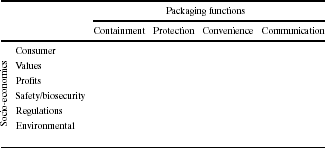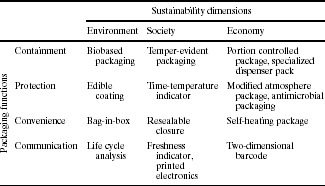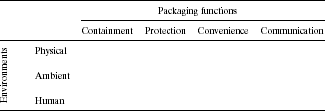Emerging food packaging technologies: an overview
Abstract:
This chapter defines the term emerging food packaging technologies and explains the socio-economic driving forces behind their development. It also discusses important considerations for identifying and evaluating emerging packaging technologies for improving the safety, quality, and sustainability of the food supply chain.
1.1 Introduction
Emerging food packaging technologies can broadly be defined as science-based packaging innovations that have passed the early stages of development and show promise to enhance food quality and safety, and improve the sustainability of the food system in general. Emerging technologies are usually in active production within five to ten years.
Innovative packaging technologies such as antimicrobial packaging, controlled release packaging, nanotechnology, biosensors, and radio frequency identification (RFID) have attracted much interest from the packaging community in recent years. Since the development of a new technology is typically costly, its need has to be justified carefully, based on the new technology's ability to enhance certain packaging functions to meet specific socio-economic needs. Any new development also needs to be based on sound science.
Sections 1.2 and 1.3 are based on Lee et al. (2008) material is reproduced with permission from Taylor & Francis Group LLC.
While new technologies are aimed at achieving certain benefits, they sometimes also create unintended problems. Replacing glass with plastics, for example, may provide the benefits of versatility and cost effectiveness, but also creates concerns about undesired compounds from the plastics migrating to the food. Replacing synthetic plastics with bio-based materials can help minimize packaging waste to the environment, but most bio-based materials have relatively poor mechanical properties.
This chapter provides an overview of the driving forces behind food packaging innovations and describes some of the processes considered for identifying and evaluating them. Examples of food packaging innovations that have advanced to the emerging technologies stage are provided elsewhere, in later chapters of this book.
1.2 Driving forces for innovations in food packaging
The food packaging industry is largely driven by the market's drive to satisfy the needs of society and the economy. Hence, the packaging innovations most needed are those that can lead to practical solutions to fulfil those socio-economic needs by delivering high quality and safe food products to the consumer in an efficient manner. Some of the major socio-economic needs that drive food packaging innovations are described below.
1.2.1 Consumer lifestyle
This is the need that drives innovations in convenient packaged foods. In recent years, consumer lifestyle has been influenced greatly by the aging population, an increasing number of smaller families, single-person households, and dual-income families. As a result, consumers are increasingly demanding food products that are convenient, taste good, are safe, wholesome, and nutritious. This has also created opportunities for innovative food packaging to satisfy target consumers in diverse demographics. For instance, packaging has played an important role in the development of convenient food products such as on-the-go snacks, microwavable foods, and refrigerated meals (also known as meal solutions).
1.2.2 Value
This need, defined as the benefits/cost ratio, is driven by the consumer. Higher benefits may be achieved by enhancing the functions of packaging to satisfy the unmet needs of the consumer. Lower cost may be achieved by using less expensive packaging materials, using high-speed machines to increase productivity, and using more compact package designs to reduce distribution costs. For instance, material cost may be reduced by replacing a thicker monolayer material with a thinner multilayer material, production speed may be increased by replacing double seamed containers with heat sealed containers, and distribution cost may be reduced by replacing heavy glass containers with plastic containers. In the effort to reduce cost, it is important that product quality and safety are not significantly compromised.
1.2.3 Profits
This need is driven by food companies to maintain or grow their businesses. To earn profits, food companies frequently rely on packaging innovations to meet the ever-changing market needs. Profits also spark intense competition in the packaging industry to fulfil market needs. For example, beverages may be packaged in different forms, including glass bottles, plastic bottles, aluminium cans, and stand-up pouches, and this provides a battleground for packaging materials suppliers to capture the market through optimization or innovation.
1.2.4 Food safety and biosecurity
This is the need that drives innovations in protective food packaging. According to estimates by the Centers for Disease Control and Prevention, each year in the United States alone, foodborne diseases cause approximately 48 million illnesses, 128,000 hospitalizations and 3,000 deaths. Microbial contamination is a major cause of foodborne illness that can occur during harvesting, processing, distributing, handling, store display and food preparation. After the tragic events of September 11 2001, food bioterror-ism (e.g., deliberate contamination of commercial food products) has become a serious public threat. Packaging can effectively protect against microbial contamination and product tampering. Innovative food packaging such as antimicrobial packaging, advanced package integrity inspection systems, tamper-evident packaging, and biochemical sensors are increasingly sought to provide enhanced food safety and biosecurity.
1.2.5 Food packaging regulations
This is the need that drives research and development relating to food packaging safety issues, such as the migration of unwanted compounds from package to food (especially during situations such as microwaving) and the use of recycled materials in food packages. The purpose of food packaging regulations is to protect the consumer against unacceptable levels of food contamination by packaging components. This has also led to a continued interest in studying the migration of packaging components under various conditions and to the development of sophisticated analytical methods to detect volatile compounds at lower concentrations.
1.2.6 Environmental concerns
This is the need that drives innovations in environmentally friendly packaging. As landfill sites are diminishing, packaging waste disposal has become a major public concern in many developed countries. There is a growing pressure for society to favor food packages that use less material and are easy to reuse, recycle, or incinerate. There is also a continued quest for bio-based and biodegradable packaging materials that have good mechanical and barrier properties.
1.3 Emerging technologies to improve the sustainability of the food supply system
In recent years there has been an increasing demand to improve the sustain-ability of the food supply system. New packaging technologies can play an important role in meeting this demand. The Sustainable Packaging Coalition, a leading organization for sustainable packaging, defines sustainable packaging as a target vision for creating 'a world where all packaging is sourced responsibly, designed to be effective and safe throughout its life cycle, meets market criteria for performance and cost, is made entirely using renewable energy, and once used is recycled efficiently to provide a valuable resource for subsequent generations' (GreenBlue, 2005). Sustainable packaging has been proposed as an holistic concept to develop packaging with three interrelated components (Lee et al., 2008). The first component is related to time and perpetuality. Sustainable packaging is aimed at not only meeting the needs of the present generation, but also the needs of future generations. It requires a cradle-to-cradle flow of packaging materials in which materials can be used repeatedly without depleting resources.
The second component is related to striking a health balance to meet the needs of the environment, society and the economy - a packaging system is not truly sustainable until all three of these are addressed in an equitable manner. For example, a packaging system with the sole purpose of maximizing profits is irresponsible if it fails to address the needs of the environment and society. Similarly, a packaging system with the sole purpose of minimizing the negative impacts to the environment is unrealistic if it fails to address the needs of society and the economy. In Fig. 1.1, sustain-ability occurs only in the shaded area where the circles of environment, society, and economy meet.
The third component is related to packaging functions (containment, protection, convenience and communication). Unless a package can perform some useful functions, the justification for its existence is questionable. For example, a package may be considered environmentally friendly because it is biodegradable; however, if it fails to protect the product, the product is likely to be discarded and not used by the consumer. Packaging functions are, unfortunately, largely overlooked in the literature when sustainable packaging is discussed. The extent to which an emerging technology is sustainable may be used as an indicator to predict its future success.
1.3.1 Packaging function considerations
A packaging design can be evaluated based on how well and cost-effectively it performs packaging’s four basic functions of protection, convenience, communication, and containment. Each of these functions is considered in turn below.
Protection
Protecting the food from physical damage, physiochemical deterioration, microbial spoilage and product tampering is probably the most important function of packaging. Without proper protection, the food may become unappetizing, less nutritious, and unsafe to consume. The packaging protection required depends on the stability and fragility of the food, the desired shelf life of the food package, and the distribution environment. Good package integrity is also required to protect against loss of hermetic condition and microbial penetration. Active packaging (such as oxygen scavengers and antimicrobial films) used to enhance the protection function, has received much attention in recent years.
Generally, the protection function of packaging is limited to foods with shelf lives controlled by environmental factors relating to physical damage, humidity, oxygen, light and, to some extent, temperature. Packaging is usually not effective for protecting foods with shelf lives controlled by internal factors, as, for example, in the case of a tuna sandwich in which moisture may migrate internally from the tuna to the bread, causing the bread to become soggy and unacceptable to the consumer. The internal moisture migration is driven by the difference in water activity between the tuna and the bread, not by the relative humidity outside the sandwich. Thus, enclosing the sandwich with a package will not solve the problem; perhaps placing an edible coating between the tuna and the bread could provide an acceptable solution.
Convenience
This is an important function to satisfy today’s busy consumer lifestyle. Examples of convenient food packages are ready-to-eat meals, heat-and-eat meals, and self-heating packages. Examples of convenient features are easy opening, resealability, and microwavability. Innovations are constantly sought to provide more convenience without sacrificing quality or increasing cost.
Communication
The function of communicating is important to create brand identity and influence consumer buying decisions. The package communicates with the consumer through written text, brand logo, and graphics. In many countries, nutritional facts such as calories, fat, cholesterol, and carbohydrate are required on all food packages. The communication function is also important to facilitate easy distribution and retail checkout. The barcode has virtually become an integral part of every commercial food package. As well as the barcode, there are other packaging devices, such as time-temperature indicators (TTI) and RFID, which enable the package to communicate more effectively for the purpose of ensuring food quality and safety. Intelligent packaging (discussed in Chapter 8 of this book) is a new technology that pushes the communication function to a higher level.
Containment
Containing the food product is the most basic function of packaging. The requirement for containment depends on the size, weight, form, and shape of the enclosed food; for example, a solid food has different requirements from a liquid food. The containment function is also closely related to the rigidity of the package.
Unless an emerging food packaging technology serves one or more of these important functions, it is unlikely to be successful.
1.3.2 Package environment considerations
Another useful consideration to help identify packaging innovations is the package environment. A package typically functions under three environments:
• Physical environment. This environment is concerned with the physical conditions that a package may encounter during its life cycle. For example, the package may have to withstand harsh temperature/pressure conditions during thermal processing, as well as shock and vibration, falls and bumps, crushing from stacking, and attack from insects and rodents during storage and distribution. To protect against these environments, the package must have adequate mechanical strength and thermal stability, as well as other properties depending on the situation.
• Ambient environment. This environment is concerned with the oxygen, moisture, odors, molds, bacteria, light and heat which are ubiquitous during storage and distribution. To protect against the negative impact of the ambient environment, the package must have adequate barrier properties, depending on the requirements of the food.
• Human environment. This complex environment is concerned with the human aspects of packaging, such as user-friendliness, liking/disliking, and the safety of a package for the consumer. Many socio-economic issues such as the impact of packaging on the environment, packaging related legislation and regulations, and packaging related litigation are largely influenced by humans. Human perception, vision, dexterity, and language are also included in this environment.
Understanding these three environments and the nature of the food product concerned is helpful in identifying useful packaging innovations.
1.4 Tables for evaluating emerging food packaging technologies
To use the information provided in the above sections, the following tables can help construct an overview of the relationships between package functions, package environments, and socio-economic needs. As such, the tables are useful for identifying and evaluating food packaging innovations.
1.4.1 Functions/socio-economic table
Table 1.1 sets packaging functions against socio-economic needs. For a particular situation, the socio-economic needs are identified and prioritized (which may or may not be the same as the examples presented in Table 1.1). Each cell in the table is considered to determine its relevance and importance. Using this table, a product development team may conclude that, for example, food safety and saving time are most important to the consumer and to the success of a new product. The team can then focus on finding innovative solutions to enhance the protection and convenience functions of the package.
1.4.2 Functions/sustainability table
In Table 1.2, sustainability dimensions (environment, society and the economy) are set against packaging functions. Examples of some existing food packaging technologies are shown and classified based on this table.
1.4.3 Functions/technologies table
In Table 1.3, packaging functions are set against technologies. This table is useful for evaluating the strengths and weaknesses of new technologies, based on their impact on packaging functions. New technologies can also be introduced to improve operational efficiency or reduce cost, preferably without compromising the existing packaging functions.
1.4.4 Functions/environments table
Table 1.4 sets packaging functions against environments and is useful for identifying innovations relating to packaging features, operations, devices, or considerations that are important for the package to function under certain environments.
It is possible to associate items to most of the cells in Table 1.4 for many food packaging systems. Although the selection and interpretation of the cell items involves somewhat subjective choices, this functions/environments table helps product development teams to consider all aspects of the food packaging system in a systematic manner. For example, analyzing the protection/human cell could suggest innovative tamper evident packaging to protect the consumer from product tampering; analyzing the protection/ ambient cell could suggest innovative active packaging to protect food products from the adverse effects of oxygen, moisture, microbes and light; and analyzing the convenience/human cell could suggest innovative micro-wavable packaging and easy-to-open packages to offer convenience to the consumer.





